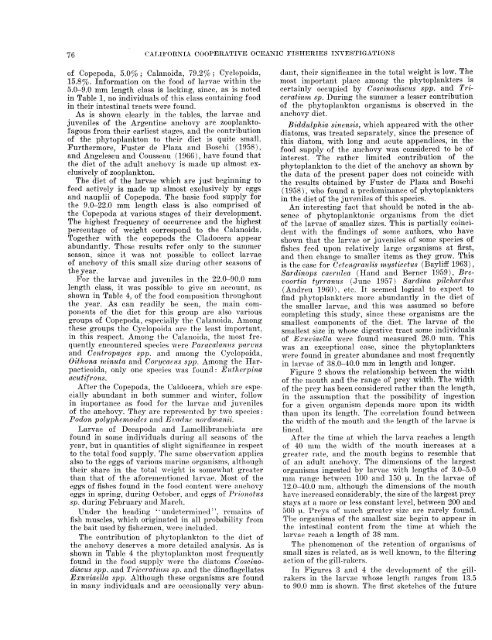CalCOFI Reports, Vol. 11, 1967 - California Cooperative Oceanic ...
CalCOFI Reports, Vol. 11, 1967 - California Cooperative Oceanic ...
CalCOFI Reports, Vol. 11, 1967 - California Cooperative Oceanic ...
You also want an ePaper? Increase the reach of your titles
YUMPU automatically turns print PDFs into web optimized ePapers that Google loves.
76 CAIJFORSIA COOPERATIVE OCEANIC FISHERIES ISVESTIGATIOKSof Copepoda, 5.0% ; Calanoida, 79.2% ; Cyclopoida,15.8%. Information on the food of larvae within the5.0-9.0 mm length class is lacking, since, as is notedin Table 1, no individuals of this class containing foodin their intestinal tracts were found.As is shown clearly in tlie tables, the larvae andjuveniles of the Argentine anchovy are zooplanktofagousfrom their earliest stages, and the contributionof the phytoplankton to their diet is quite small.Furthermore, Fuster de Plaza and Boschi (1958),and Angelescu and Cousseau (1966), have found thatthe diet of the adult anchovy is made up almost exclusivelyof zooplankton.The diet of the larvae which are just beginning tofeed actively is made up almost exclusively by eggsand nauplii of Copepoda. The basic food supply forthe 9.0-22.0 mm length class is also comprised ofthe Copepoda at various stages of their development.The highest frequency of occurrence and the highestpercentage of weight correspond to the Calanoida.Together with the copepods the Cladocera appearabundantly. These results refer only to the summerseason, since it was not possible to collect larvaeof anchovy of this small size during other seasons ofthe year.For the larvae and juveniles in the 22.0-90.0 mmlength class, it was possible to give an account, asshown in Table 4, of the food composition throughoutthe year. As can readily be seen, the main componentsof the diet for this group are also variousgroups of Copepoda, especially the Calanoida. Amongthese groups the Cyclopoida are the least important,in this respect. Among the Cal;inoidu, the most frequentlyencountered species were Paracalaniis parczisand Centropages spp. and among the Cyclopoida,Oithona nzinuta and Corycaczis spp. Among the IIarpacticoida,only one species was found : Eictherpinaacutifrons.After the Copepoda, the Caldocera, which are especiallyabundant in both summer and winter, followin importance as food for the larvae and juvenilesof the anchovy. They are represented by two species:Po don p o 1 y p h em o ides and E 13 a d?z c ti o r d nt a nii.Larvae of Decapoda and Lainellibranchiata arefound in some individuals during all seasons of theyear, but in quantities of slight significance in respectto the total food supply. The same observation appliesalso to the eggs of various marine organisms, althoughtheir share in the total weight is somewhat greaterthan that of the aforementioned larrae. Most of theeggs of fishes found in the food content were anchovyeggs in spring, during October, and eggs of Prionotzissp. during February and March.Under the heading " undetermined ' ', remains offish muscles, which originated in all probability fromthe bait used by fishermen, were included.The contribution of phytoplankton to the diet ofthe anchovy deserves a more detailed analysis. As isshown in Table 4 the phytoplankton most frequentlyfound in the food supply were the diatoms Coscinodiscusspp. and Triceratizirn sp. and the dinoflagellatesExuviaella spp. Although these organisms are foundin many individuals and are occasionally very abun-dant, their significance in the total weight is low. Themost important place among the phytoplankters iscertainly occupied by Coscinodiscus spp. and Triceratiunzsp. During the summer a lesser contributionof the phytoplankton organisms is observed in theanchovy diet.Biddulphia sinensis, which appeared with the otherdiatoms, was treated separately, since the presence ofthis diatom, with long and acute appendices, in thefood supply of the anchovy was considered to be ofinterest. The rather limited contribution of thephytoplankton to the diet of the anchovy as shown bythe data of the present paper does not coincide withthe results obtained by Fuster de Plaza and Boschi(1958), who found a predominance of phytoplanktersin the diet of the juveniles of this species.An interesting fact that should be noted is the absenceof phytoplanktonic organisms from the dietof the larvae of smaller sizes. This is partially coincidentwith the findings of some authors, who haveshown that the larvae or juveniles of some species offishes feed upon relatively large organisms at first,and then change to smaller items as they grow. Thisis the case for Cdenyraulis mysticetiis (Bayliff 1963))Xardinops caeriilea (Hand and Berner 1959) , Brevoortiafyrranzis (June 1957) Sardina pilchardiis(Andreu 1960). etc. It seemed logical to expect tofind phytoplankters niore abundantly in the diet ofthe smaller larvae, and this was assumed so beforecompleting this study, since these organisms are thesmallest components of the diet. The larvae of thesmallest size in whose digestive tract some individualsof Exziviaella were found measured 26.0 mm. Thiswas an exceptional case, since the phytoplankterswere found in greater abundance and most frequentlyin larvae of 38.0-40.0 mm in length and longer.Figure 2 shows the relationship between the widthof the mouth and the range of prey width. The widthof the prey has been considered rather than the length,in the assumption that the possibility of ingestionfor a given organism depends more upon its widththan upon its length. The correlation found betweenthe width of the mouth and the length of the larvae islineal.After the time at which tlie larva reaches a lengthof 40 imn the width of the mouth increases at agreater rate, and the mouth begins to resemble thatof an adult anchovy. The dimensions of the largestorganisms ingested by larvae with lengths of 3.0-5.0mm range between 100 and 150 p. In the larvae of12.0-40.0 mm, although the dimensions of the mouthhare increased considerably, the size of the largest preystays at a more or less constant level, between 200 and500 p. Preys of much greater size are rarely found.The organisms of the smallest size begin to appear inthe intestinal content from the time at which thelarrar reach a length of 38 mm.The phenomenon of the retention of organisms ofsinall sizes is related, as is well known. to tlie filteringaction of the gill-rakers.In Figures 3 and 4 the development of the gillrakersin the larvae whose length ranges from 13.5to 90.0 mm is shown. The first sketches of the future















